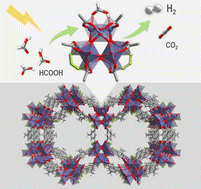Active site imprinting on Ti oxocluster metal–organic frameworks for photocatalytic hydrogen release from formic acid†
Abstract
On-board hydrogen release from liquid organic carriers is a process that can make feasible the use of H2 as a transportation fuel. Formic acid is considered as one of the most convenient liquid hydrogen organic carriers, and since it can be easily obtained from CO2, it is water soluble which makes it unnecessary to recover the H2-depleted byproducts. Compared to the more conventional thermal catalytic decomposition of formic acid, the use of light in combination with a photocatalyst has been much less explored. Herein, we report a new paradigm in MOF photocatalysis with the use of a microporous titanium oxocluster based metal–organic framework (Ti-MOF) endowed with formate-imprinted active sites, namely MIP-177-LT (MIP stands for Materials from Institute of Porous Materials of Paris, LT for Low Temperature), as a highly efficient photocatalyst for H2 release from formic acid without the need to neutralize acidity or use sacrificial agents or noble metals. Noteworthily, a quantum efficiency of 22% has been determined for the photocatalytic H2 release that is highly remarkable for a non-toxic noble metal-free photocatalyst.



 Please wait while we load your content...
Please wait while we load your content...